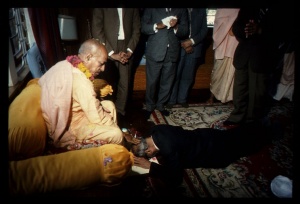CC Adi 7.14

A.C. Bhaktivedanta Swami Prabhupada
TEXT 14
eka mahāprabhu, āra prabhu duijana
dui prabhu seve mahāprabhura caraṇa
SYNONYMS
eka mahāprabhu—one Mahāprabhu, or the supreme predominator; āra prabhu duijana—and the other two (Nityānanda and Advaita) are two prabhus (masters); dui prabhu—the two prabhus (Nityānanda and Advaita Gosāñi); seve—serve; mahāprabhura—of the supreme predominator, Lord Caitanya Mahāprabhu; caraṇa—the lotus feet.
TRANSLATION
One of Them is Mahāprabhu, and the other two are prabhus. These two prabhus serve the lotus feet of Mahāprabhu.
PURPORT
Although Śrī Caitanya Mahāprabhu, Śrī Nityānanda Prabhu and Śrī Advaita Prabhu all belong to the same Viṣṇu category, Śrī Caitanya Mahāprabhu is nevertheless accepted as the Supreme, and the other two prabhus engage in His transcendental loving service to teach ordinary living entities that every one of us is subordinate to Śrī Caitanya Mahāprabhu. In another place in the Caitanya-caritāmṛta (CC Adi 5.142) it is said, ekale īśvara kṛṣṇa, āra saba bhṛtya: the only supreme master is Kṛṣṇa, and all others, both viṣṇu-tattva and jīva-tattva, engage in the service of the Lord. Both the viṣṇu-tattva (as Nityānanda Prabhu and Advaita) and the jīva-tattva (śrīvāsādi-gaura-bhakta-vṛnda) engage in the service of the Lord, but one must distinguish between the viṣṇu-tattva servitors and the jīva-tattva servitors. The jīva-tattva servitor, the spiritual master, is actually the servitor God. As explained in previous verses, in the absolute world there are no such differences, yet one must observe these differences in order to distinguish the Supreme from His subordinates.